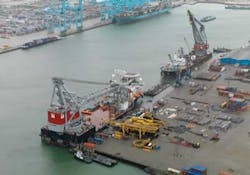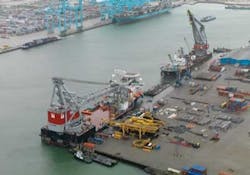Online monitoring enhances flow assurance
Marit Larsen
FMC Technologies
New oil and gas field developments are getting more advanced and often include subsea installations, satellite wells, or subsea-to-beach solutions. Long multiphase lines, tie-ins, subsea-to-beach, and subsea production and processing can pose different operational challenges. One of the most critical challenges is to ensure efficient flow of the produced oil and gas.
The Flow Assurance System (FAS) is designed to monitor subsea equipment and well production to give operators necessary information about production content. Subsea hardware now can be equipped with lots of sensors, meters, and advanced instrumentation to provide continuous information about flow conditions. However, there is limited or no instrumentation along the flowline to give needed flow condition data. Thus, operators are forced to rely on multiphase models as virtual measurements.
Flow assurance challenges also increase as the flowline length and water depth increase. Other critical situations also can arise, such as equipment failure, wearing down of the choke, and leakage or blockage of pipelines.
An adverse situation, such as a flow rate issue or equipment malfunction, can cost the operator time and money and may become an environmental hazard. If changes in normal conditions are detected early, unplanned shut-downs of wells may be avoided.
To help operators address flow assurance challenges, FMC Technologies developed its FAS system, Flow Manager. The first installation of the online metering included in this system was in 1995. Today, the system meters some 470 oil and gas wells worldwide.
As the complexity of the field development increases, online systems require extended functionality. Statoil’s Vega field in the North Sea is one successful FAS example. Statoil uses FAS to manage the unique flow assurance problems presented at Vega field.
Unique challenges
Vega is a gas condensate field near Norway’s west coast. It will be developed as a tie-in to the Gjøa platform with a 167,322-ft (51 km) flowline. The field development covers three reservoirs and is split between two licenses. The subsea layout is an in-line daisy-chain with a four-slot template for each reservoir. Each reservoir will be produced by two wells for a total of six wells in the field. One multiphase meter will be installed on each well and on each template manifold. Statoil’s production strategy for Vega is based on reservoir depletion.
Because of the subsea conditions, several operational and flow assurance challenges have been defined by Statoil. These challenges include high reservoir pressure, low temperature during start-up and shut-down, the possibility of hydrate or wax formation, the liquid accumulation effect on ramp-up time, and the need to operate within safe pressure and temperature margins. Unexpected situations also occur such as failing or reduced performance of the subsea sensors and multiphase flow meters, leakage in the production line and the MEG injection monitoring and control system, or blockage of the production line.
Different modes
The main objectives of the Vega FAS are to produce safely and to minimize the shut down/restart periods. In order for the FAS to satisfy the different needs of field production, four different modes were developed.
The “Real Time” mode runs in parallel with the real process. It reads sensor values and control parameters from the process control system and automatically adapts the FAS models to the real process. Using the FAS in the Real Time mode, the user has a continuously updated metering, monitoring, and surveillance system.
The “Look Ahead” mode of FAS runs in parallel with the Real Time system and continuously simulates the predicted process behavior for a defined time horizon. It always begins with the current process conditions, and simulates what will happen if the process runs without change. This allows the user to look into the future to get an early warning in time to make any necessary corrective actions.
The “What If” simulator may be used to train, analyze, or plan. The purpose of this mode is to run scenarios and analyze the consequences of changing system set points prior to modifications. It also can analyze flow assurance situations that have occurred or are suspected. This mode can improve operational procedures and regularity, such as start-up and ramp-up procedures. The “What If” operating mode is connected to the actual process only indirectly, so it can read the current state in Real Time and use that data as an initial condition for the simulation.
“Look Back” mode provides advanced FAS users with a flexible tuning system to adjust the multiphase models in Vega FAS against the Vega field production data. This mode is available in the Web interface.
Functionalities for Vega’s challenges
Different Flow Manager systems were used when developing the Vega FAS, which is a customized application that addresses the specific needs of the Vega field operation.
The Virtual Flow Metering System measures individual well production rates as a redundancy to the multiphase meters at each wellhead. This virtual metering system does not depend on single sensors or the multiphase meters, so it serves as an accurate back-up to the physical meters. It also calculates pressure and temperatures along the flow path, including downhole and reservoir pressures.
Three subsea templates tieback to Gjøj platform.
The Pipeline Management System monitors the flowline. To counter the long flowline and dynamic behavior associated with Vega, the dynamic multiphase flow simulator OLGA was integrated. This dynamic model enables functionality such as the MEG injection monitoring and control, pig tracking, calculation of liquid accumulation, prediction of flow instabilities, and other transient effects.
To achieve optimal ramp-up of wells, manifolds, and pipelines, the Production Choke Control System was included in the Vega FAS. This system recommends flow set points for the production chokes based on operator-defined production targets and constraints. The production strategy contains well-priority, planned gas production, swing wells, and maximum choke openings.
An early indication of potential break-downs of sensors and equipment is crucial to planning maintenance. As such, the Condition Performance Monitoring System monitors the real-time status of subsea sensors, multiphase meters, production chokes, and other flow-related process equipment.
To guard against wax build-up and hydrate formation, and for an early indication of leakage and blockage, FMC Technologies added the Wax Condition Monitoring, the Hydrate Condition Monitoring, and the Leakage and Blockage Monitoring systems to the Vega FAS.
User interface
The Vega FAS includes an organized Web-based graphical user interface. This tool includes feature such as process pages that illustrate the field lay-out from the wells through the flowline and into the topside facilities. Output about the flowing conditions such as flow rates, pressures, temperatures, liquid content, and control parameters for the equipment are shown in various positions. Available measurements are integrated into the pages.
Other examples include special advice pages configured to show hydrate, wax, pig, and performance monitoring. Typical FAS users are in multiple locations. The control room operator is usually at the Gjøa platform and the production engineer or flow assurance specialist works primarily onshore in the Statoil offices. The Web interface has different access levels to meet the different users’ needs. The Vega FAS’s accessible Web interface gives different users within the Statoil organization a common tool that can improve communication and provide a common understanding about Vega’s production status.
Enhanced decision making
Great effort has been put into the flow assurance advisors and the performance monitoring of the subsea production system. Improved measurements and improved field management give increased production. However, it is not the measurements themselves that lead to increased and safe production; it is the interpretation of these measurements. Because of this, a main objective of the Vega FAS is to contribute numbers as well as to provide a better understanding of flow assurance issues as a support for correct decisions. Through the Vega FAS, operators, production engineers, and flow assurance specialists have a tool to monitor the production process, plan for various scenarios, and to give early warnings in time to implement contingency plans.
Offshore Articles Archives
View Oil and Gas Articles on PennEnergy.com



